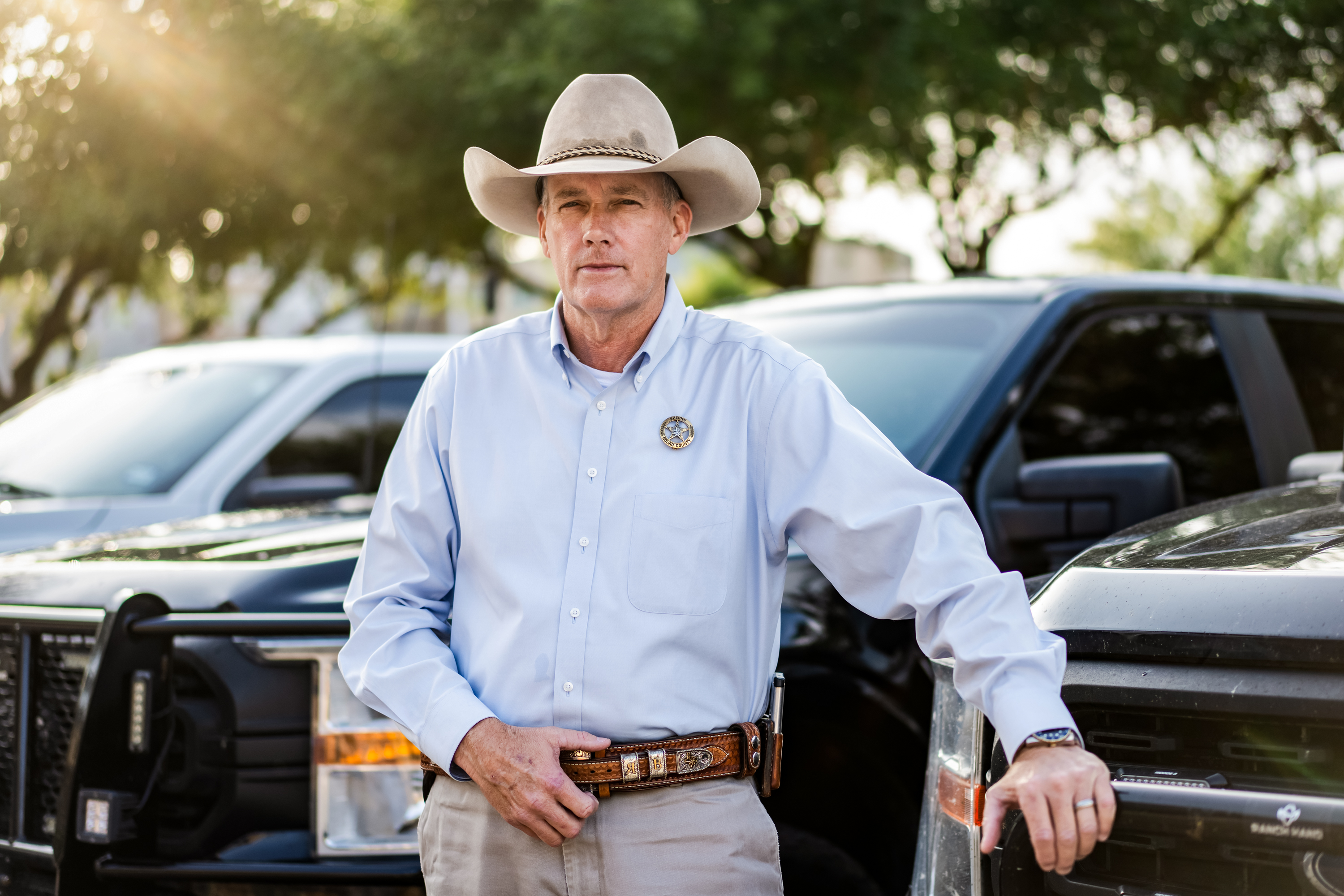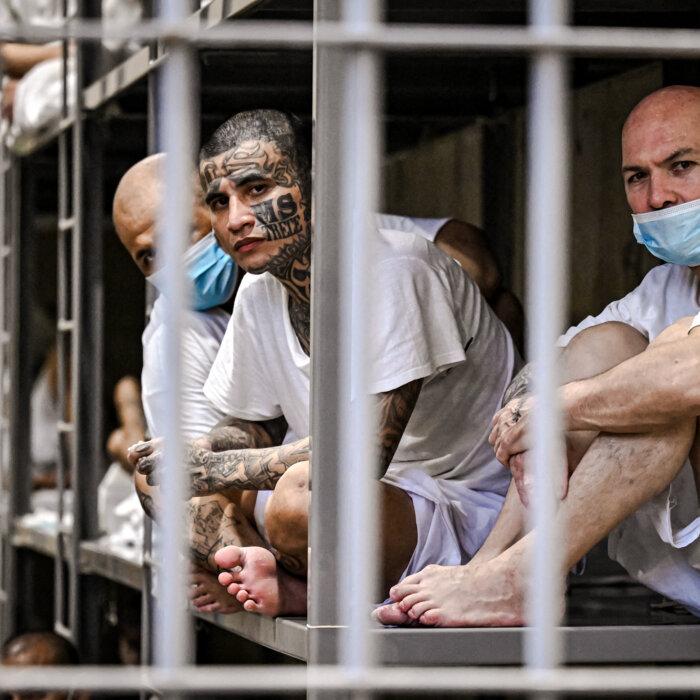Texas sheriff Roy Boyd has the look of a legendary lawman—all whipcord and sinew, from the tip of his leather boots to the top of his sweat-stained cowboy hat.
It’s easy to imagine him riding a horse into an orange sunset among the purple shadows of century plants and the Trans-Pecos scorpions of West Texas, where people still pray for rain.
The get-’er-done Goliad County sheriff—a seventh-generation Texan with steely eyes, a square jaw, and an engraved Colt .45 on his hip—believes in God, America, and its borders.
Goliad County, home to about 7,100 souls, has more cows than people. It is known as the site of the 1836 Goliad massacre, which took place during the Texas Revolution. Some say the ghosts of war remain.
The county sits about halfway between the border city of Laredo and the big city of Houston, making it a prime human trafficking route and stash site for Mexican cartels and smuggling organizations.
Boyd told The Epoch Times that after taking office in 2021, he was having none of it.
One Sunday morning that same year, Boyd said he and his son were driving near Goliad when he saw a pickup truck and noticed a bunch of fingers and hands sticking out from underneath a sheet of plywood covering the truck bed.
The veteran lawman knew the truck was carrying illegal immigrants.
He flipped on his police lights and told his son: “Well, we’re going to have to stop them, and they’re going to run, so get ready.”
With the pursuit on, the truck took off into a pasture, got stuck in the mud, then crashed through a fence.
Boyd watched the doors fly open and the occupants scatter through the field like jackrabbits.
He sprung out of his vehicle with his AR-15 rifle in hand and jumped onto the bumper of the truck.
“Stay down!” he yelled at the illegal immigrants remaining in the bed of the truck.
Backup was on the way, so he handed his AR-15 to his son. The 12-year-old knew how to handle the rifle, the sheriff said.

“Just cover me. I gotta start zip-tying them,” he told his son.
After backup arrived, Boyd took a photo and sent it to Texas Gov. Greg Abbott’s office.
He wanted to get the governor’s attention. Lawmen needed more money and equipment to deal with the border crisis and crime that came with it.
Boyd decided to take a page out of the cartel playbook and leave a public warning in 2021. He made several 8-foot by 4-foot signs in Spanish telling the cartels he wasn’t messing around.
In English, Boyd’s sign read: “Warning, traffickers of humans and drugs, turn around and go around; do not be near the county of Goliad. We will hunt you down and throw you in jail.”
Not long afterward, the Department of Homeland Security (DHS) called Boyd to say the Gulf Cartel was passing around a photo of him standing by one of the signs.
Help Wanted
Since then, Boyd has become well known for working with state and federal authorities to help curb illegal immigration and combat cartels.
A key part of his toolbox is an agreement with Immigrations and Customs Enforcement (ICE) that has been described by border czar Tom Homan as a “force multiplier” for ICE.
Sheriffs in 39 states have signed what’s known as 287(g) agreements. They give state and local law enforcement authority to perform specific immigration officer functions. They cover jail enforcement, immigration authority, and executing and serving warrants on illegal immigrants.
At the annual National Sheriffs’ Association meeting in Washington in February, Homan emphasized the importance of the agreements, particularly when it comes to providing ICE with much needed jail space.
“The sheriffs in the room, we need your bed space. We need your 287(g) agreements,” he said.
Homan has encouraged local law enforcement to sign the agreements in the hopes of creating a safe deportation pipeline, in cooperation with ICE. Immigration officers can pick up deportees within a controlled jail setting, for example, rather than having to organize an operation out in the community.

Boyd said there are three types of 287(g) agreements and each one is vital to national security.
The agreements date back to 1996, when Section 287(g) was added to the Immigration and Nationality Act.
Boyd is one of only eight sheriffs nationwide who have signed all three agreements in early May.
The jail enforcement model is the best known of the three models. It allows designated local law enforcement to identify and process removable noncitizens who have been arrested and booked into local jails on local or state charges.
The task force model deputizes local law enforcement officers to arrest foreign nationals for being in the country illegally and place detainers on them during routine policing, such as traffic stops, without requiring a separate criminal charge. In essence, it allows local law enforcement to operate as an extension of ICE under federal supervision.
Agreements Surge
According to ICE data, 133 law enforcement agencies in 21 states had signed on to the federal-state agreements as of last November.That number has surged since President Donald Trump took office again in January.

However, according to ICE, sheriff’s offices using all three agreements only exist in three states as of May 1—Texas, Florida, and Kentucky.
In Texas, besides Boyd, only sheriffs in Calhoun, Jim Wells, and Winker counties have signed up for all three models.
Goliad County had a jail model during the Biden administration.

‘Hundreds of Years’
Some 11 million illegal immigrants were apprehended at U.S. borders over the past four years, according to Customs and Border Protection data. Trump campaigned on border security and illegal immigrant deportations.Trump has moved to keep that promise through a whole-of-government approach that has included designating several Mexican cartels and other transnational criminal groups as terrorist organizations. As a result, some members of the MS-13 and Tren de Aragua gangs have been deported to El Salvador’s Terrorism Confinement Center, known as CECOT.
Neither number accounts for the gotaways who sneak into the country undetected.

Homan said 130,000 illegal immigrants were deported during Trump’s first 100 days.
At that rate, Boyd said, it could take hundreds of years to deport the millions of illegal immigrants in the United States.
Local law enforcement needs to get on board, he said. The Goliad sheriff said many local law enforcement agencies have side-stepped the illegal immigration issue by calling it a federal problem.
Beyond the Jail Model
The 287(g) agreements stand to be a key component of the federal government’s deportation efforts, because there are not enough ICE agents nationwide to apprehend the 1.4 million illegal immigrants with final deportation orders, let alone the millions of others.
Boyd said the agency needs the help of local lawmen, but the federal government could be doing a better job marketing and explaining the programs to state and local law enforcement.
Most only know about the jail model, which leaves out a critical piece of the puzzle in fighting organized crime, Boyd said.
Calling jails “a natural choke point” for identifying criminal aliens, the report says the 287(g) model has turned up “startling numbers” of removable criminal aliens.
In one example, Harris County, Texas, issued more than 10,000 detainers—most involving serious offenses—in the first 10 months after it implemented a 287(g) program in 2008. An ICE detainer allows for a jail to hold an illegal immigrant for up to 48 hours longer than the regular release time, so that ICE agents can take custody.
However, the report notes, the other 287(g) models “provide equally important crime-fighting benefits and are a useful tool to address such illegal immigration-related crime problems as alien smuggling, drugs, street gangs, and identity theft.”
Moreover, Boyd said many sheriffs mistakenly view the local law enforcement agreements with ICE as unfunded mandates that will cost them time and money.
Ammon Blair, an intelligence consultant and senior fellow at the Texas Public Policy Foundation’s Secure & Sovereign Texas Initiative, told the Epoch Times that he recently met a Texas sheriff who operates a large-scale jail model but had no knowledge of the task force model.
“What is very concerning is the lack of knowledge within the [law enforcement] community,” Blair said.
Washington needs to step up efforts to educate sheriffs on all three models, he said.

State-Level Efforts
Currently, participation in the 287(g) program is voluntary in Texas. While bills have been introduced in the current Texas Legislative session to require local law enforcement to apply for at least one agreement, only one bill has progressed.If the bill is enacted into law, applying for an ICE agreement would remain optional for smaller counties, but it would make grant money available to those counties to support their participation in the 287(g) program.
Meanwhile, Florida is lightyears ahead, Blair said. Florida’s governor organized its model, and the state created a new agency to organize and coordinate it.
Ride Along
The Epoch Times joined Goliad County deputies during an operation in Waller County, Texas, as part of an Operation Lone Star task force looking for drugs and illegal immigrants.While no illegal immigrant arrests were witnessed by The Epoch Times, about 25 were apprehended during the operation, according to Boyd.
However, Boyd had to release all but four of the illegal immigrants he apprehended. An ICE response would take hours, he was told, and since he couldn’t hold the individuals any longer without a federal detainer—which was not provided—he had to release all but four.
Ultimately, ICE picked up two of the four. “Why they would not take them all is beyond me,” Boyd said. The two remaining illegal immigrants also had to be released, as required by law.
That won’t happen once Goliad has fully implemented the task force model because it gives his office the power to issue a detainer under ICE supervision, Boyd said.
Until then, Boyd said he has received assurances that Border Patrol agents or ICE agents will be on hand during special operations to authorize detention and coordinate transportation for illegal immigrants.

Less Crime in Goliad
Boyd credits his success in fighting cartel-related crime in part to Goliad’s 287(g) agreement.The county already had the jail model in place in 2020, he said, which helped to get illegal immigrants removed instead of being forced to release them back into the community.
“I do think it contributed to our success,” he said.
Goliad County Sheriff’s Sgt. Melvin Slovak, a retired military veteran who served in the Middle East during the rise of the ISIS terrorist group, said his boss always prioritizes his deputies and runs operations with them.
Slovak has worked at the sheriff’s office for four years and said the entire county has noticed a change since Boyd began focusing on cartel-related crime.
Slovak has become skilled at recognizing human smugglers.
One clue is their appearance, he said. Smugglers are often dressed well, he said, while the illegal immigrants they transport are often dressed in camo and look thin and hungry.
Boyd said the county was “overrun” with smuggling in the first two years of his term, beginning in January 2021. But last year, only 55 arrests were made for smuggling.
As the cartel-related crimes went down, so did the routine burglaries and thefts in the county, Slovak told The Epoch Times..
“If you’re going to mess around in Goliad, you’re going to jail.”
















